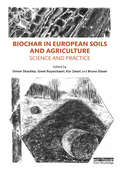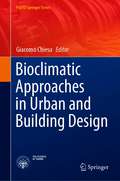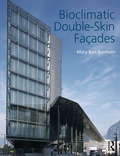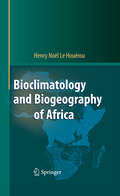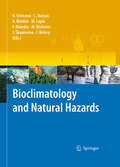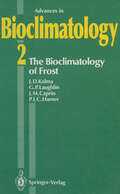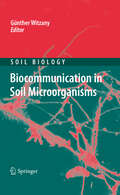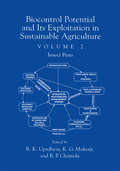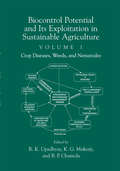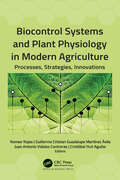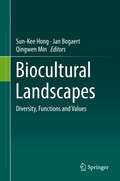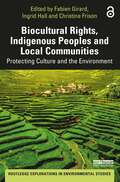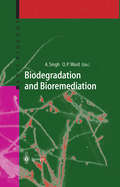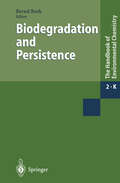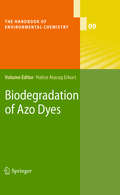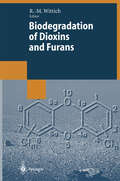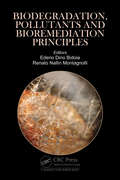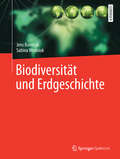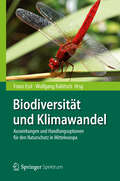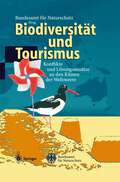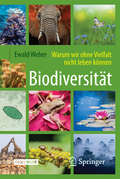- Table View
- List View
Biochar in European Soils and Agriculture: Science and Practice
by Simon Shackley Greet Ruysschaert Kor Zwart Bruno GlaserThis user-friendly book introduces biochar to potential users in the professional sphere. It de-mystifies the scientific, engineering and managerial issues surrounding biochar for the benefit of audiences including policy makers, landowners and farmers, land use, agricultural and environmental managers and consultants, industry and lobby groups and NGOs. The book reviews state-of-the-art knowledge in an approachable way for the non-scientist, covering all aspects of biochar production, soil science, agriculture, environmental impacts, economics, law and regulation and climate change policy. Chapters provide ‘hands-on’ practical information, including how to evaluate biochar and understand what it is doing when added to the soil, how to combine biochar with other soil amendments (such as manure and composts) to achieve desired outcomes, and how to ensure safe and effective use. The authors also present research findings from the first coordinated European biochar field trial and summarize European field trial data. Explanatory boxes, infographics and concise summaries of key concepts are included throughout to make the subject more understandable and approachable.
Biochar in European Soils and Agriculture: Science and Practice
by Simon Shackley Greet Ruysschaert Kor Zwart Bruno GlaserThis user-friendly book introduces biochar to potential users in the professional sphere. It de-mystifies the scientific, engineering and managerial issues surrounding biochar for the benefit of audiences including policy makers, landowners and farmers, land use, agricultural and environmental managers and consultants, industry and lobby groups and NGOs. The book reviews state-of-the-art knowledge in an approachable way for the non-scientist, covering all aspects of biochar production, soil science, agriculture, environmental impacts, economics, law and regulation and climate change policy. Chapters provide ‘hands-on’ practical information, including how to evaluate biochar and understand what it is doing when added to the soil, how to combine biochar with other soil amendments (such as manure and composts) to achieve desired outcomes, and how to ensure safe and effective use. The authors also present research findings from the first coordinated European biochar field trial and summarize European field trial data. Explanatory boxes, infographics and concise summaries of key concepts are included throughout to make the subject more understandable and approachable.
Bioclimatic Approaches in Urban and Building Design (PoliTO Springer Series)
by Giacomo ChiesaThis book explores the bioclimatic approach to building design. Constant innovations in the field are evident, including the need to face climate changes and increase the local resilience at different scales (regional, urban, architectural). Differently from other contributions, this book provides a definition of the bioclimatic design approach following a technological and performance-driven vision. It includes one of the largest collection of research voices on the topic, becoming also a critical reference work for bioclimatic theory. It is intended for architects, engineers, researchers, and technicians who have professional and research interests in bioclimatic and in sustainable and technological design issues.
Bioclimatic Double-Skin Façades
by Mary Ben BonhamVisually enriched with over 250 photographs and drawings, Bioclimatic Double-Skin Façades is an essential reference guide for understanding the types and functions of double-skin façades. Author Mary Ben Bonham examines the history and continuing potential of double-skin architecture, informing on the variety of approaches possible and advising a rigorous integrated design process leading to application. Featuring a wide selection of architectural examples, the book will be of interest to professionals and students within the fields of architecture, engineering, and construction. Characterized by a buffer-like air space between two glazed building skins, double-skin windows and façades aim to improve building comfort and energy performance. Double skins introduce complexity and initial costs, yet significant buildings in locations around the globe continue to select this approach. In addition to exploring motivations, benefits, and cautions for designing with double skins, the book provides a primer on fundamental façade design concepts and strategies for control of thermal, luminous, and acoustic environments. Chapters also address alternative types of high-performance façades and implications for each phase of façade design and construction. Bioclimatic Double-Skin Façades promotes bioclimatic design that is inspired by nature, measured in performance, and uniquely adapted to climate and place. In-depth case studies illustrate how double-skin façades have been adapted to a range of climates and cultural settings: Marseille Library and Grenoble Courthouse in France, Cambridge Public Library in Massachusetts, Manitoba Hydro Place in Canada, and the Pearl River Tower in China.
Bioclimatic Double-Skin Façades
by Mary Ben BonhamVisually enriched with over 250 photographs and drawings, Bioclimatic Double-Skin Façades is an essential reference guide for understanding the types and functions of double-skin façades. Author Mary Ben Bonham examines the history and continuing potential of double-skin architecture, informing on the variety of approaches possible and advising a rigorous integrated design process leading to application. Featuring a wide selection of architectural examples, the book will be of interest to professionals and students within the fields of architecture, engineering, and construction. Characterized by a buffer-like air space between two glazed building skins, double-skin windows and façades aim to improve building comfort and energy performance. Double skins introduce complexity and initial costs, yet significant buildings in locations around the globe continue to select this approach. In addition to exploring motivations, benefits, and cautions for designing with double skins, the book provides a primer on fundamental façade design concepts and strategies for control of thermal, luminous, and acoustic environments. Chapters also address alternative types of high-performance façades and implications for each phase of façade design and construction. Bioclimatic Double-Skin Façades promotes bioclimatic design that is inspired by nature, measured in performance, and uniquely adapted to climate and place. In-depth case studies illustrate how double-skin façades have been adapted to a range of climates and cultural settings: Marseille Library and Grenoble Courthouse in France, Cambridge Public Library in Massachusetts, Manitoba Hydro Place in Canada, and the Pearl River Tower in China.
Bioclimatology and Biogeography of Africa
by Henry N. HouérouCovering an area of over 130 million km2 spanning the Mediterranean, equator and tropics, the African continent features a spectacular geographic diversity. Consequently, it is characterised by extremely variable climatic, edaphic and ecological conditions, associated with a wide range of natural vegetation and wildlife, as well as human population density, crops and livestock. In this book, Henry Le Houérou presents his bioclimatic and biogeographic classification of Africa. The extensive data provide the basis for comparisons between various African regions, and with regions on other continents such as Latin America or the Indian subcontinent. The results constitute a rational basis for national, regional and sub-regional rural development planning, and for agricultural research dealing with aspects such as plant and animal introductions, the extrapolation or interpolation of experimental or developmental findings, and ecosystems dynamics. Possible problems of applications are also examined.
Bioclimatology and Natural Hazards
by Katarína Strelcová Miroslav Blazenec Jan Holecy Axel Kleidon Milan Lapin Frantisek Matejka Csaba Matyas Jaroslav SkvareninaAnthropogenic influences to the earth's system, including the atmosphere, hydrosphere, biosphere, cryosphere and lithosphere, represent a serious challenge to our planet's ecosystems and natural environments. Bioclimatology, hydrology, bio-hydrology and eco-physiology are important scientific research areas with wide application to environmental protection, forestry, agriculture and water management, and protection against natural hazards including droughts, floods, windstorms, weather extremes, and wild fires. Bioclimatology helps to better understand the causes and impacts of natural hazards and how to prevent them. Improved knowledge of natural hazards is a vital prerequisite for the implementation of integrated resource management. It provides a useful framework for combating current climate variability and for adapting to ongoing climate change. This book presents research on the interactions between meteorological, climatological, hydrological and biological processes in the atmospheric and terrestrial environment. It highlights a spectrum of topics associated with climate change and weather extremes and their impact on different economic sectors. The contributing authors come from renowned scientific research institutions and universities and specialise in issues of climate change, soil-plant-atmosphere interactions, hydrologic cycle, ecosystems, biosphere, and natural hazards.
The Bioclimatology of Frost: Its Occurrence, Impact and Protection (Advances in Bioclimatology #2)
by J. D. Kalma G. P. Laughlin J. M. Caprio P.J.C. HamerThe economic costs of frosts in agriculture and horticulture in many parts of the world can be very significant. Reports in the media include accounts on how frosts have devastated coffee crops in Brazil or in Papua New Guinea, and how frosts have seriously damaged the Florida citrus industry. Frost may cause losses in current harvests or a decline in future yields through more permanent damage to trees and bushes. Damaging frosts may occur as infrequent, short-term events with sub-zero temperatures or with unusually severe winter temperatures which extend over long periods. In this book we have aimed at providing a comprehensive review of recent advances in the area of frost research. The stimulus for writing this book has come from the recognition that there is a shortage of recent texts which deal exclusively with the bioclimatology of frost. Bioclimatology deals with the relations between climate and life and the present text is particularly concerned with the effects of low temperatures on plants. Our purpose has been to assist researchers, engineers, extension officers and students in understanding the physical aspects of frost occurrence and frost distribution as well as the biological and phenological aspects of frost damage and to provide an overview of direct and indirect methods of frost pro tection and prevention.
Biocommunication in Soil Microorganisms (Soil Biology #23)
by Günther WitzanyCommunication is defined as an interaction between at least two living agents which share a repertoire of signs. These are combined according to syntactic, semantic and context-dependent, pragmatic rules in order to coordinate behavior. This volume deals with the important roles of soil bacteria in parasitic and symbiotic interactions with viruses, plants, animals and fungi. Starting with a general overview of the key levels of communication between bacteria, further reviews examine the various aspects of intracellular as well as intercellular biocommunication between soil microorganisms. This includes the various levels of biocommunication between phages and bacteria, between soil algae and bacteria, and between bacteria, fungi and plants in the rhizosphere, the role of plasmids and transposons, horizontal gene transfer, quorum sensing and quorum quenching, bacterial-host cohabitation, phage-mediated genetic exchange and soil viral ecology.
Biocontrol Potential and its Exploitation in Sustainable Agriculture: Volume 2: Insect Pests
by Rajeev K. Upadhyay K. G. Mukerji B. P. ChamolaPlant based Biotechnology has come to represent a means of mitigating the problems of global food security in the twenty first century. Products and processes in agriculture are increasingly becoming linked to science and cutting edge technology, to enable the engineering of what are in effect, designer plants. One of the most successful, non chemical approaches to pest management and disease control, which seeks a solution in terms of using living organisms to regulate the incidence of pests and and pathogens, providing a `natural control' while still maintaining the biological balance with the ecosystem. This volume, describes the various biological agents used to control insect pests of a variety of crops. Readers may also be interested in Volume 1: Crop diseases, Weeds and Nematodes, published in December 2000, ISBN 0-306-46460-8.
Biocontrol Potential and its Exploitation in Sustainable Agriculture: Crop Diseases, Weeds, and Nematodes
by Rajeev K. Upadhyay K. G. Mukerji B. P. ChamolaPlant based biotechnology has come to represent a means of mitigating the problems of global food security in the twenty-first century. Products and processes in agriculture are increasingly becoming linked to science and cutting edge technology, to enable the engineering of what are in effect, designer plants. One of the most successful , non-chemical approaches to pest management and disease control is biological control, which seeks a solution in terms of using living organisms to regulate the incidence of pests and pathogens, providing a natural control' while still maintaining the biological balance with the ecosystem. This volume, (the first of two), addresses the different types of biocontrol for different pests, namely, crop diseases, weeds and nematodes, and details the biology of both the pest and its enemies, which is vital for efficient use of biological control. The book has numerous contributors who are authorities in their fields, and would be an asset to those who have interest in sustainable agriculture and crop productivity.
Biocontrol Systems and Plant Physiology in Modern Agriculture: Processes, Strategies, Innovations
by Romeo Rojas Guillermo Cristian Guadalupe Martínez Ávila Juan Antonio Vidales Contreras Cristóbal Noé AguilarBiocontrol Systems and Plant Physiology in Modern Agriculture: Processes, Strategies, Innovations focuses on new production alternatives that do not include pesticides, herbicides, or chemicals for primary food production and instead rely on biologically controlled systems of production. The book also relates a number of advances and innovations in the use of agricultural technologies that employ the study of the physiology of plants to know their resistance to different environments in modern agriculture. The book presents research offering viable alternatives for the control of pests for safe food production that are environmentally friendly and that facilitate the reduction of production costs and improve the quality and yield of produce. The volume addresses innovative biocontrol systems to reduce or eliminate the use of agrochemicals by controlling plant diseases by minimizing environmental damage through the use of antagonistic organisms. It also presents new strategies of cultivation that maximize production by optimizing light, temperature, humidity, nutrients and humidity in a controlled environment. The diverse topics in the volume include botanical compounds as adjuvants as an alternative to reduce the pesticide use, on-site production of bio-control agents, plant factory systems that offer controlled safe environments for plant cultivation, promising bio-nematicides for sustainable agriculture, wastewater reclamation for agricultural purposes, the recovery of phytochemicals from plants, using LED lights on plants and microgreens production, and much more. Covering the new trends in biological control, plant factories, and plant metabolism for application in modern agriculture, this volume provides important research and knowledge that facilitates environmentally friendly plant systems, advances the reduction of production costs, and improves the quality and yield of produce.
Biocultural Landscapes: Diversity, Functions and Values
by Sun-Kee Hong Jan Bogaert Qingwen MinThis book is devoted to the cultural and biological dimensions and values of landscapes, linking the concepts of biodiversity, landscape and culture and presenting an essential approach for landscape analysis, interpretation and sustainable dynamics.Early chapters explore the concepts and values of biocultural landscapes, before addressing the methodology to identify the relationship between biological and cultural diversity. The volume continuous with a series of case studies and with an exploration of the key role of biocultural diversity in contemporary landscape ecology.Readers will learn the importance of landscapes for different fields of natural and human sciences and are confronted to the trans-disciplinary nature of the landscape concept itself. A hierarchical approach to landscapes, in which they are composed of interacting (eco)systems, is shown to be essential in recognizing their emergent properties.In this work, the biocultural values of landscapes are explored through their diversity in geographical scopes, methodological approaches and conceptual assumptions. Authors from Asia, Europe and North-America present diverse research experiences and views on biocultural landscapes, their pattern, conservation and management.Landscape ecologists will find this work particularly appealing, as well as anyone with an interest in sustainable landscape development, nature conservation or cultural heritage management.This volume is the outcome of a symposium on “Biodiversity in Cultural Landscapes”, organized in the framework of the 8th IALE World Congress, held in Beijing in 2011.
Biocultural Rights, Indigenous Peoples and Local Communities: Protecting Culture and the Environment (Routledge Explorations in Environmental Studies)
by Fabien GirardThis volume presents a comprehensive overview of biocultural rights, examining how we can promote the role of indigenous peoples and local communities as environmental stewards and how we can ensure that their ways of life are protected. With Biocultural Community Protocols (BCPs) or Community Protocols (CPs) being increasingly seen as a powerful way of tackling this immense challenge, this book investigates these new instruments and considers the lessons that can be learnt about the situation of indigenous peoples and local communities. It opens with theoretical insights which provide the reader with foundational concepts such as biocultural diversity, biocultural rights and community rule-making. In Part Two, the book moves on to community protocols within the Access Benefit Sharing (ABS) context, while taking a glimpse into the nature and role of community protocols beyond issues of access to genetic resources and traditional knowledge. A thorough review of specific cases drawn from field-based research around the world is presented in this part. Comprehensive chapters also explore the negotiation process and raise stimulating questions about the role of international brokers and organizations and the way they can use BCPs/CPs as disciplinary tools for national and regional planning or to serve powerful institutional interests. Finally, the third part of the book considers whether BCPs/CPs, notably through their emphasis on "stewardship of nature" and "tradition", can be seen as problematic arrangements that constrain indigenous peoples within the Western imagination, without any hope of them reconstructing their identities according to their own visions, or whether they can be seen as political tools and representational strategies used by indigenous peoples in their struggle for greater rights to their land, territories and resources, and for more political space. This volume will be of great interest to students and scholars of environmental law, indigenous peoples, biodiversity conservation and environmental anthropology. It will also be of great use to professionals and policymakers involved in environmental management and the protection of indigenous rights.
Biocultural Rights, Indigenous Peoples and Local Communities: Protecting Culture and the Environment (Routledge Explorations in Environmental Studies)
by Fabien Girard Ingrid Hall Christine FrisonThis volume presents a comprehensive overview of biocultural rights, examining how we can promote the role of indigenous peoples and local communities as environmental stewards and how we can ensure that their ways of life are protected. With Biocultural Community Protocols (BCPs) or Community Protocols (CPs) being increasingly seen as a powerful way of tackling this immense challenge, this book investigates these new instruments and considers the lessons that can be learnt about the situation of indigenous peoples and local communities. It opens with theoretical insights which provide the reader with foundational concepts such as biocultural diversity, biocultural rights and community rule-making. In Part Two, the book moves on to community protocols within the Access Benefit Sharing (ABS) context, while taking a glimpse into the nature and role of community protocols beyond issues of access to genetic resources and traditional knowledge. A thorough review of specific cases drawn from field-based research around the world is presented in this part. Comprehensive chapters also explore the negotiation process and raise stimulating questions about the role of international brokers and organizations and the way they can use BCPs/CPs as disciplinary tools for national and regional planning or to serve powerful institutional interests. Finally, the third part of the book considers whether BCPs/CPs, notably through their emphasis on "stewardship of nature" and "tradition", can be seen as problematic arrangements that constrain indigenous peoples within the Western imagination, without any hope of them reconstructing their identities according to their own visions, or whether they can be seen as political tools and representational strategies used by indigenous peoples in their struggle for greater rights to their land, territories and resources, and for more political space. This volume will be of great interest to students and scholars of environmental law, indigenous peoples, biodiversity conservation and environmental anthropology. It will also be of great use to professionals and policymakers involved in environmental management and the protection of indigenous rights.
Biodegradation and Bioremediation (Soil Biology #2)
by Dr Ajay SinghIn this volume, experts from universities, government labs and industry share their findings on the microbiological, biochemical and molecular aspects of biodegradation and bioremediation. The text covers numerous topics, including: bioavailability, biodegradation of various pollutants, microbial community dynamics, properties and engineering of important biocatalysts, and methods for monitoring bioremediation processes. Microbial processes are environmentally compatible and can be integrated with non-biological processes to detoxify, degrade and immobilize environmental contaminants.
Biodegradation and Persistence (The Handbook of Environmental Chemistry #2 / 2K)
by B. BeekBiodegradation is a key phenomen among environmental processes. Low degradation rates lead to the persistence of chemicals in the environment and, as a consequence, to delayed or long-term effects, which may be even unknown by now. In this volume the editor has pulled together the newest results of research in biodegradation and persistence of potential environmentally harmful substances and the complex process involved. The main focus is on the microbial degradation, the evolution and predictability of the respective pathways and their impact on bioremediation. Additional chapters deal with sewage treatment plants, the impact of toxicants on impaired biodegradation, and with the need of a more realistic view on fate and behaviour of chemicals in the environment.
Biodegradation of Azo Dyes (The Handbook of Environmental Chemistry #9)
by Hatice Atacag Erkurt M. Arshad H. Atacag Erkurt U. C. Banerjee L. Bardi R.M.F. Bezerra Ö. Çinar D. Crowley K. Demiröz A. A. Dias A. Di Donato E. A Erkurt J. Guo L. Kang A. Khalid R. Khan R. Liu X. Lu M. S. Lucas A. Marzocchella M. Marzona M. A. Mazmanci G. Olivieri J. A. Peres P. Salatino A. Sampaio S. Sandhya A. Unyayar X. Wang J. YangAzo dyes play an important role as coloring agents in the textile, food, and pharmaceutical industry. Due to the toxicity, mutagenicity and carcinogenicity of azo dyes and their breakdown products, their removal from industrial wastewaters has been an urgent challenge. Promising and cost-effective methods are based on their biodegradation, which is treated in this volume. The topics presented by experts in the field include: the classification of azo dyes; toxicity caused by azo dyes; aerobic and anaerobic azo dye biodegradation mechanisms; the role of bacteria, fungi, algae and their enzymes in biodegradation; the impact of redox mediators on azo dye reduction; the integration of biological with physical and chemical processes; the biotransformation of aromatic amines; reactor modelling for azo dye conversion; the biodegradation of azo dyes by immobilized bacteria and fungi; and factors affecting the complete mineralization of azo dyes.
Biodegradation, Pollutants and Bioremediation Principles
by Ederio Dino BidoiaThis book presents a broad compendium of biodegradation research and discussions on the most up-to-date bioremediation strategies. The most relevant microbiological, biochemical and genetic concepts are presented alongside the fundamentals of bioremediation. The topics include: a wide variety of contaminant impacts evaluation, key methodologies required to measure biodegradation and propose new bioremediation protocols, as well as the handling of microbial communities related to such processes. The selected collaborating authors are renowned for their microbiology expertise and will provide an in-depth reference for students and specialists. The contents provide a valuable source of information for researchers, professionals, and policy makers alike.
Biodegradation, Pollutants and Bioremediation Principles
by Ederio Dino Bidoia Renato Nallin MontagnolliThis book presents a broad compendium of biodegradation research and discussions on the most up-to-date bioremediation strategies. The most relevant microbiological, biochemical and genetic concepts are presented alongside the fundamentals of bioremediation. The topics include: a wide variety of contaminant impacts evaluation, key methodologies required to measure biodegradation and propose new bioremediation protocols, as well as the handling of microbial communities related to such processes. The selected collaborating authors are renowned for their microbiology expertise and will provide an in-depth reference for students and specialists. The contents provide a valuable source of information for researchers, professionals, and policy makers alike.
Biodiversität und Erdgeschichte
by Jens Boenigk Sabina WodniokDieses inspirierende und motivierende Lehrbuch zeichnet fächerübergreifend ein beeindruckendes Gesamtbild der biologischen Vielfalt. Spannende Aspekte der Evolution der Erde und des Lebens werden durch interdisziplinäre Verknüpfung geowissenschaftlicher und biowissenschaftlicher Aspekte aus einer ganz neuen Perspektive anschaulich vermittelt. Der Schwerpunkt liegt hierbei – unter Einbeziehung aktuellster wissenschaftlicher Erkenntnisse – auf dem Verständnis von Konzepten und Mechanismen.Dieses Buch richtet sich an Studierende der Bio- und Geowissenschaften und an alle an der Vielfalt des Lebens interessierten Leser. Das innovative Lehrbuchkonzept regt – gleichzeitig als Lesebuch, Bilderbuch und Lexikon der organismischen Biologie – sowohl Anfänger als auch Fortgeschrittene zu einem visuellen und intuitiven Lernen an. Jede Doppelseite bietet ein in sich geschlossenes, anschaulich bebildertes Kapitel mit themenbezogenem Glossar und weiterführenden Verweisen. Für Dozenten und Lehrer, für Schule und Hochschule bietet dieses Buch ein reichhaltiges Nachschlagewerk und einen umfassenden Fundus an didaktisch durchdachten und lernfreundlich illustrierten Lehrmaterialien.Der Inhalt reicht von der Entstehung der Erde über die geowissenschaftlichen Rahmenbedingungen und die Verknüpfung zwischen biologischer und geologischer Evolution bis zur Entstehung des Menschenvon grundlegenden Mechanismen der Entstehung und Erhaltung der Diversität bis zur globalen Verteilung der heutigen Biodiversitätvon den Anfängen der biologischen Systematik in der griechischen Philosophie und der Bibel über die darwinsche Evolution und die Struktur und Funktion von Arten und Organismen bis zu den modernen Erkenntnissen der Megasystematik und Phylogenie.Mit diesem einzigartigen Konzept verschafft dieses Lehrbuch einen soliden Überblick über die Erdgeschichte und Biodiversität. Die Verknüpfung der verschiedenen Fachdisziplinen fördert das Verständnis übergeordneter Prinzipien und naturwissenschaftlicher Zusammenhänge.
Biodiversität und Klimawandel: Auswirkungen und Handlungsoptionen für den Naturschutz in Mitteleuropa
by Stefan RahmstorfDas Buch bietet einen zusammenfassenden Überblick über die Effekte des Klimawandels auf die Biodiversität in Mitteleuropa. Im Mittelpunkt steht die Bewertung der beobachteten und prognostizierten Folgen für Arten und Lebensräume sowie die Ableitung von Handlungsoptionen. Die Autoren berücksichtigen die Zusammenhänge mit der Land- und Forstwirtschaft, Jagd und Fischerei sowie Implikationen für die Gesundheitsvorsorge. Auch die Wechselwirkungen mit globalen Entwicklungen wie biologische Invasionen oder der Landnutzungswandel werden diskutiert.
Biodiversität und Tourismus: Konflikte und Lösungsansätze an den Küsten der Weltmeere
by I. DahmsDie "Konvention über die biologische Vielfalt", ein Ergebnis der Konferenz der Vereinten Nationen für Umwelt und Entwicklung (UNCED) 1992 in Rio de Janeiro, hat die verschiedenen internationalen Naturschutzbemühungen erstmals auf eine umfassende, globale Grundlage gestellt. Die unterzeichnenden Staaten verpflichten sich die biologische Vielfalt der Erde zu schützen und gleichzeitig nachhaltig zu nutzen. Eine der Nutzungen, die Auswirkungen auf die globale Biodiversität haben, ist der Tourismus. Hier werden am Beispiel vorwiegend europäischer Küstenregionen, den Hauptzentren des Tourismus, Konflikte zwischen Naturschutz und touristischer Nutzung erläutert und Lösungsansätze zur Minimierung von Konflikten vorgestellt.
Biodiversität - Warum wir ohne Vielfalt nicht leben können
by Ewald WeberEine Einladung in die Biologie der Vielfalt Dieses Buch berichtet über ein ebenso spannendes wie aktuelles Thema an der Schnittstelle zwischen naturwissenschaftlicher Grundlagenforschung und globaler gesellschaftlicher Herausforderung: die Biodiversität. Drei Ebenen kommen hier zusammen: die Vielfalt der Arten in einem Lebensraum, die Vielfalt der Ökosysteme und Lebensräume selbst und die Vielfalt der Gene in den Lebewesen. Der Autor, Biologe und selbst in der Biodiversitätsforschung tätig, nimmt Sie mit auf eine aufregende Entdeckungsreise durch diese mannigfach vernetzte Welt. In leicht verständlicher Sprache und mit vielen anschaulichen Beispielen erklärt er Zusammenhänge und Hintergründe. Wie ist Biodiversität eigentlich definiert, und mit welchen Techniken wird sie erfasst? Wie ist die immense Artenvielfalt auf der Erde entstanden, und wie entwickelt sie sich weiter? Welchen Nutzen hat die Biodiversität auf den verschiedenen Ebenen? In welchem Maße ist die Vielfalt der Arten und Lebensräume heute bedroht, und wie kann man diesem Trend entgegenwirken? Solche und ähnliche Fragen beantwortet dieses Buch, in dessen breitem Themenbogen sich die Vielfalt seines Gegenstands wiederspiegelt. Tauchen Sie ein in die faszinierende Welt der Biodiversität! Der AutorEwald Weber ist Biologe und Sachbuchautor. Er lehrt und forscht an der Universität Potsdam mit Schwerpunkt Biodiversität. Sein Anliegen als Autor ist das Vermitteln von wissenschaftlichen Zusammenhängen und von Naturgeschichte im weitesten Sinn.
